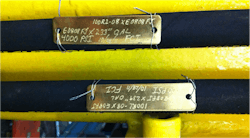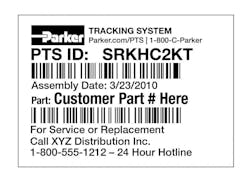For owners and operators of industrial machinery or mobile equipment, accurately identifying components in need of replacement can result in a frustrating scramble for paper manuals or misplaced documentation. Typically, removing the failed component and driving it to a dealer or repair center for identification and replacement is the only option. This however can be time consuming and come at a significant expense to the operation. These are the unfortunate and realistic challenges of supporting many different pieces of multi-branded equipment. Additionally, planning for and documenting appropriate inspection and maintenance incidents can be a cumbersome and arduous process, which can lead to safety or other compliance issues and result in unplanned downtime and unnecessary expenses.
Systems approach and control integration
Most industrial markets share common issues: to minimize operational downtime, to better identify hydraulic and related systems due to inexperienced or untrained staff, to identify MRO sourcing plans and to perform appropriate and timely scheduled maintenance.
Awareness has been heightened to the need for regular component inspection and replacement, especially in regulated markets such as oil and gas and mining. Operators are being held to a higher standard with respect to routine maintenance and traceability of key system components.
Some companies attempt a pro-active approach using spreadsheets, paper forms or tags to document their hoses or critical components. Unfortunately, these methods are not very effective, can be cumbersome to administer, may not last and do not inform staff when preventative maintenance is required nearly as efficiently as needed.
In October 2009, Parker Hannifin’s Hose Products Division launched the Parker Tracking System (PTS), a global asset tagging and identification system comprised of a Web-based software application and highly engineered labels and printer systems. PTS is built on open, industry-standard software architecture and uses proven technology from Zebra and Motorola to generate unique product tags. PTS is used for nearly all Parker-manufactured OEM and distributor hose assemblies that the company makes worldwide.
Access to the PTS application is managed per customer, per site and per user for complete control and security.
PTS features a unique and visual alphanumeric identification code on each label. Using one of several trillion possible codes, no two hose assemblies will ever share the same PTS I.D. This allows Parker to uniquely measure performance in numerous environments or operating conditions. The system enables authorized distributors, dealers or otherusers to quickly and accurately replace a hose assembly by using only the PTS identification number found on the label. Barcodes and optional RFID (Radio Frequency Identification) technologies are used to enhance identification and reduce errors.
It takes many years of experience and training to accurately identify a component by sight. Without this knowledge, mistakes can occur, resulting in wasted expenses and lost productivity. By using PTS, every assembly can be replaced quickly, easily and exactly the way it was originally made, ensuring a perfect fit for the application.
PTS tagging can be supplied directly from Parker, authorized Parker distributors and select OEMs.
PTS labels are engineered for weather, chemical and abrasion resistance and extreme heat or cold.
Tags include a variety of customizable information. Each tag includes the PTS ID, assembly creation date, customer part number, barcode and customizable information. Additional data is entered and stored in the secure online database, including:
- Customer information
- Bill of material/comments
- Application data
- Replacement details
- Replacement history
To help understand equipment performance, powerful system-wide reporting tools are available for creating on-demand reports. These reports can include tags deployed by location or machine, past failures by asset or equipment type.
OEMs and operators can easily locate assets to be maintained, establish a standard cadence for inspection or replacement activities and attach critical linked files such as pressure tests, prints or application photos. Including as much relevant data as possible for each component saves critical time at the moment a replacement is needed. The PTS application holds all the data ready for the user to recall it to obtain an exact replacement.
Key tool in preventive maintenance
Today, PTS covers millions of hose assemblies, thousands of registered users and hundreds of tagging locations worldwide in dozens of participating countries.
Avoiding the ineffective “fix-when-fail” strategy for running operations is one of PTS’ main benefits. Sophisticated operators are seeking a more efficient and intelligent solution to predictive and planned maintenance and inspections. Most know that this will drive machine uptime and preserve profitability. PTS seamlessly integrates asset documentation, tracking inspection and maintenance records to drive greater operational efficiency.
Current tools such as spreadsheets and basic ID tags offer no notifications and are not a pro-active approach for scheduling maintenance, especially across a large or multi-location enterprise. Using PTS, customers can create custom inspection templates and document asset inspection activities on a global basis. With the user-friendly software, it is possible to:
- Personalize inspection criteria,
- Establish mandatory compliance activities,
- Provide maintenance teams with asset location data and history,
- Document audit activities, and
- Schedule work by site, equipment type or criticality level of asset.
Inspection templates are created and applied to one or thousands of components. By entering data for retrieval later, users can then easily establish maintenance procedures or schedule work based upon their preferences. Additional assets can be assigned, relocated or transferred at any point.
Unscheduled replacement of assemblies due to issues such as abrasion, corrosion or kinking can be recorded to predict the necessity or timing of future replacements. When replacement parts are needed, the customer simply calls ahead with the PTS ID number, giving the distributor or service partner advance notice to retrieve the assembly details from the system. This includes hose and fitting part numbers, assembly length, optional sleeving, accessories and even proper cleaning specifications. With such detail in hand, the distributor can make the assembly and have it ready for pick-up when the customer arrives. If special parts have to be ordered, no wasted trips are incurred. Parts can be shipped or delivered for added convenience.
Value in use
With more than 24 countries actively participating, PTS is the only true global system in use by a manufacturer such as Parker. The same hose that is tagged by an OEM in Germany, for example, can be replaced in the United States, and vice versa. With more and more equipment being shipped all over the world, the global database enables Parker’s OEM customers to facilitate hydraulic hose replacement on their equipment, regardless of the country of origin. PTS provides value in many ways to a variety of markets, including Oil and Gas, Mining and In-Plant Automotive.
A project is currently underway for a global oil and gas drilling rig operator to document and inspect every hydraulic hose and tubing system onboard the company’s off-shore rigs. This enables the company to comply with a variety of governmental and industry requirements and may assist in avoiding unnecessary fines or shutdowns. PTS can also provide useful analytics on the historical performance of hoses in a variety of applications.
This oil and gas company has outsourced the documentation and inspection of its hoses to a local Parker distributor. In this case, PTS will save approximately 80-120 labor hours per year for this single site, resulting in $8000 to $12,000 per year in savings, but more importantly, it will provide a much-needed service to the customer who was without this type of maintenance resource in-house.
Parker’s service provider is now supporting the customer with contract maintenance services, providing critical documentation, compliance, preventative maintenance and even removal and off-site disposal of worn assemblies. The value of the knowledge greatly exceeds the labor costs saved.
Consider that the average operating cost of an off-shore rig can range from approximately $500,000 to $1 million per day. If PTS can save 30 minutes of time to identify and reorder one failed hose assembly in a full year of operation, the result is a direct cost avoidance of more than $12,000 per site. The risk of such an occurrence makes it easy for customers to justify the adoption of PTS to protect themselves and their assets.
Conclusion
PTS is used in a wide variety of applications in which customers want to track assets and manage necessary inspections and replacements. While initially developed for hydraulic hose assemblies, PTS is currently rolling out to numerous Parker engineered components. PTS can provide customers with increased operational efficiency, regulatory compliance and safety documentation for all critical assets.
Bill Sayavich is Business Development Manager at Parker Hannifin's Hose Products Div., Wickliffe, Ohio. For more information, visit www.parker.com/pts.




